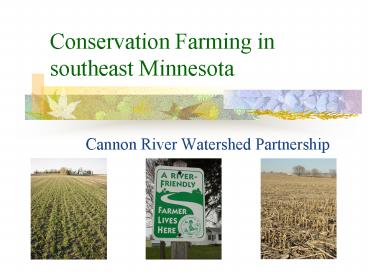Conservation Farming in southeast Minnesota PowerPoint PPT Presentation
1 / 21
Title: Conservation Farming in southeast Minnesota
1
Conservation Farming in southeast Minnesota
- Cannon River Watershed Partnership
2
Ag-Related Water Quality Problems
- Sedimentation (from erosion)
- Excess N and P (from fertilizers)
Sedimentation of rivers can result from soil
erosion on farms.
Photo MPCA. 2000. Oxygen-poor dead zone
links Gulf of Mexico with Minnesota waters.
Minnesota Environment, Nov. 2000. Accessed
online at http//www.pca.state.mn.us/publications
/mnenvironment/fall2000/hypoxia.html. Used with
permission.
3
Conservation Farming Practices
- Crop Rotation
- No-Till
- Nutrient Management
- Integrated Pest Management
- Conservation Buffers
4
Perennial Crop Rotations
- Incorporate perennials (alfalfa) and small grains
(oats, barley) into planting sequence - increases ground cover and root area
- decreases erosion and nutrient loss
- breaks pest life cycles
5
No-Till
- Leave crop residue on the fields and plant w/
seed drill - increases ground cover
- decreases erosion
- Increases water infiltration
6
Nutrient Management
- Test soil and plant tissue N
- Consider all N sources (manure, crop residue,
legumes) - Apply only what is needed
7
Integrated Pest Management
- Cultural Control Crop rotation, Altered Planting
Dates - Biological Control Maintain soil invert
populations (natural predators) - Chemical Control Apply only after field
examination
8
Conservation Buffers
- Maintain land in permanent vegetation (grass
waterways, riparian forest, etc.) - slows runoff
- filters sediment and nutrients
- stabilizes streambanks
9
Benefits of Conservation Farming
- Soil Resources
- Water Resources
- Energy Resources
- Economic Productivity
10
Higher Soil Organic Matter
Soil Resources
- Nutrients for crop growth
- Soil aggregation and porosity
- Stabilizes soil against erosion
11
Lower Soil Compaction
Soil Resources
- Enhances water infiltration
- Prevents rapid runoff and soil erosion
12
Higher Soil Moisture
Soil Resources
- (samples taken during grain-filling period
Aug./Sept.)
13
Higher Soil Invertebrate Populations
Soil Resources
- Contribute to Nutrient Recycling
- Maintain porous soil (burrowing)
- Control crop pests
14
Water Resources
Water Resources
- Collection station for measuring runoff
15
Lower Runoff Volume
Water Resources
- Porous soil structures
- Cover crops (crop rotation)
- Crop residue (no till)
increase infiltration
16
Lower N Loss in Runoff
Water Resources
- Crop Rotation deep roots of perennials take up
nutrients - No Till low erosion prevents nutrient loss
17
Lower Fossil Fuel Use
Energy Use
- Decreased fertilizer and pesticide use
- Decreased machinery and fuel use
18
Higher Corn and Soybean Yields
Economic Productivity
- Higher soil fertility
- Higher soil moisture
19
Technical and Financial Assistance for
Conservation Farming
- Government Programs
- SWCD Resources
20
Govt Incentive and Cost Share
- Conservation Security Program (CSP)
- Environmental Quality Incentives Program (EQIP)
- Conservation Reserve Program (CRP)
- Wetlands Reserve Program (WRP)
21
SWCD Resources
- One-on-one conservation planning
- Application assistance

